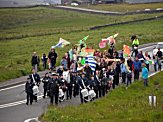
History
Flash Bar Stores takes its name from the tollhouse built here in 1771 which is still in existence today. A tollgate, or toll bar, was in operation here on the site of the road that ran from Macclesfield to Longnor via Three Shires head, which dissects the current A53.
There is a vast history in this area documented in two local books by Margaret Parker; “Flash Back” available in Flash Bar Stores. The Flash Loyal Union friendly society was established in 1846. Known as the Tea Pot Club by 1906, it was dissolved in the early 1990s. It was set up in order to collect money for members of the community if they fell ill or a burial had to be paid for. The money was collected in a teapot. It was a great sense of community support before the days of the NHS. Three Shires Head is a popular Beauty Spot on the site where the three counties of Staffordshire, Cheshire and Derbyshire meet. The Pack Horse Bridge runs over the river and waterfalls tumble into the river.
Panniers pool is a famous swimming spot at this site. There is more information on the
Lud Church Blog (great info about the local area). There is an extensive history of the village at
British History Online (which also casts doubt on stories of counterfeiting money at Flash in the past).
"During the first half of the C19th the population was around 700; it had been reduced to half this by the end of the 1800's.
There were also stonemasons, dress makers, blacksmiths and cordwainers, and a shoemaker, errand boy, wheelwright, game-keeper, grocer, peddler and tailor, as well as a number of house servants, 275 young people and 50 scholars. At one time 29 families (78 individuals) were receiving weekly relief and 23 families (87 individuals) occasional relief, nearly a quarter of the population." "The first record of coal mining in Flash comes from 1401 when Thomas Smith took a year's lease on the 'vein coal' of Black Brook, near Upper Hulme (probably at Blue Hills). There were a large number of coal pits in the Flash area (including Orchard Common, Blackclough, Hope, Goldsitch and Knotbury) which were worked throughout the C18th and C19th, and some into the early C20th, for both commercial and domestic use."
 The Tea Pot parade still takes place every Summer with a service and parade from Flash across the A53 terminating at Flash Bar. It is a unique event, where the Marching Band accompanies the community carrying a Tea Pot. A range of entertainment is available to make it a great day out for all.
more
The Tea Pot parade still takes place every Summer with a service and parade from Flash across the A53 terminating at Flash Bar. It is a unique event, where the Marching Band accompanies the community carrying a Tea Pot. A range of entertainment is available to make it a great day out for all.
more
There is an excellent little history booklet available in the parish church,
(St. Paul's, Quarnford). From this we learn of the silk mill at Gradbach (less than 2 miles west ) from 1640 to 1840, with silk weaving and button making as cottage industries throughout the Parish. In the 18th century, a gang used button presses to make counterfeit coins (hence the name "Flash Money") but some were hanged at Chester after a servant girl gave them away.
In 1851 there were 40 agricultural labourers, about the same number of silk worker (spinners, spreaders, reelers and button makers), and almost as many colliers.
![]()